
Economics_-_New_Ways_of_Thinking
.pdf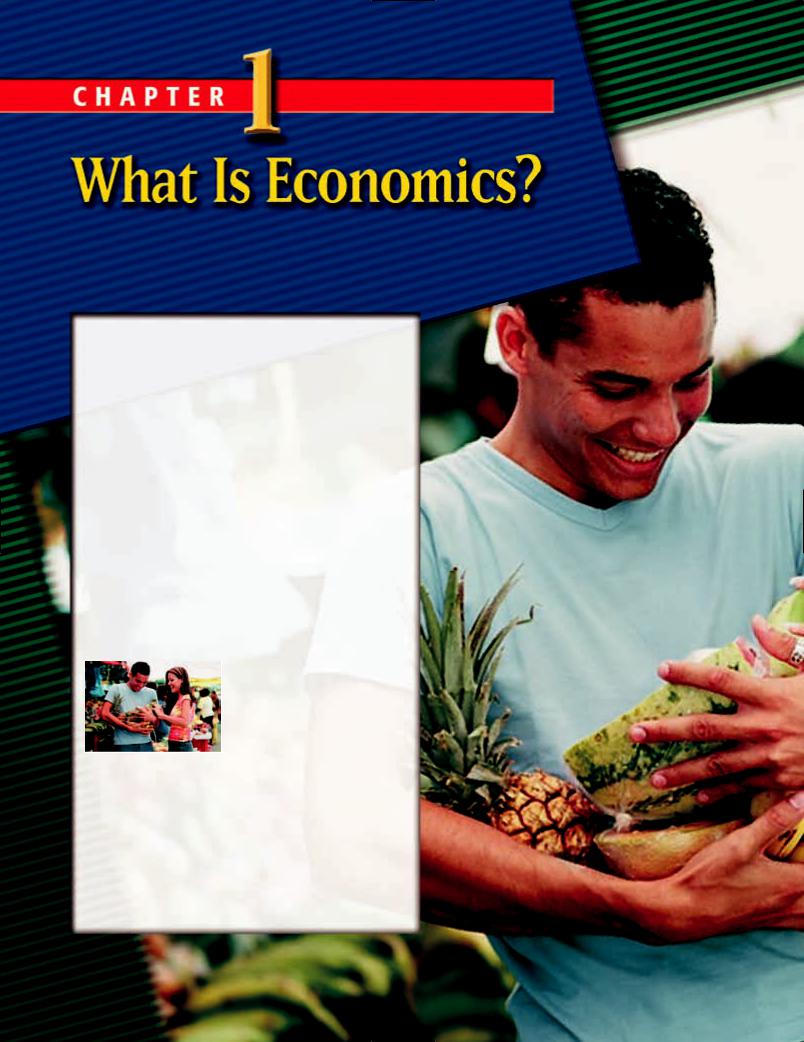
Why It Matters
Simple arithmetic is both useful and powerful. It is useful because almost every day you have some reason to add, subtract,
multiply, or divide. Just think how much harder your life would be if you did not know simple arithmetic.
Basic arithmetic is powerful because it is the springboard to higher mathematics and to deeper understanding. You could not learn algebra or geometry without knowing how to add, subtract, multiply, and divide. Without algebra and geometry, safe bridges could not be built and satellites could not be put into space.
The economic concepts discussed in this chapter are similar to addition, subtraction, multiplication, and division. How are they similar? First, as with arithmetic, once you learn basic economics, you will be able to use these concepts continually to get more of what you want out of life. Second, these concepts form the basis
These shoppers probably |
for the economics you will |
|
can’t afford to buy every- |
||
learn in later chapters. You |
||
thing they would like, but |
||
will not be able to under- |
||
their choices appear to |
||
stand economic “algebra,” so |
||
have been satisfying. In |
||
to speak, without first learn- |
||
this text you’ll learn how |
||
ing the fundamental eco- |
||
people make these sorts |
||
nomic concepts explained in |
||
of choices. |
||
|
this chapter. |
|
|
4

The following events occurred one day in November.
8:12 A.M. Jessica is a senior in high school; next year she hopes to enroll in a college that is very selective. Currently she is at home filling out one of the many college applications on
her desk. The acceptance rate at this particular college is 14 percent. Jessica whispers under her breath, “Why such a low acceptance rate?”
• Why is it so hard to get into certain colleges?
8:33 A.M. Each morning on his way to work, George, 30 years old, drives through a senior citizen community. It usually takes him longer to go one-half mile in
the senior citizen community than to go one-half mile anywhere else along his commute. George is currently going 15 mph in a 25 mph zone because the person driving in
front of him is driving 15 mph. George is frustrated because he has no way to get around this slow driver.
• What economic reason might explain why, on average, senior citizens drive slower than 30-year- old drivers?
7:43 P.M. José, a junior in high school, is at home studying. José’s mother is surprised that he is home studying on a Saturday night. Usually he is out with his friends. She asks, “What are you doing home tonight? Do you have a big test next week?” José answers, “No, it’s just that Jimmy is sick and
Tom is out of town.”
• What do José’s friends either being sick or out of town have to do with his studying on a Saturday night?
8:45 P.M. David and Elaine Anderson are at home watching television. They are thinking of buying a new car, so after the last Volvo commercial Elaine says, “I wonder if we should buy a new Volvo, maybe an S80 [starting price, $36,365].” As he gets up to get something to drink, David says, “There goes the vacation to Maui.”
• What does buying a car have to do with taking a vacation?
5
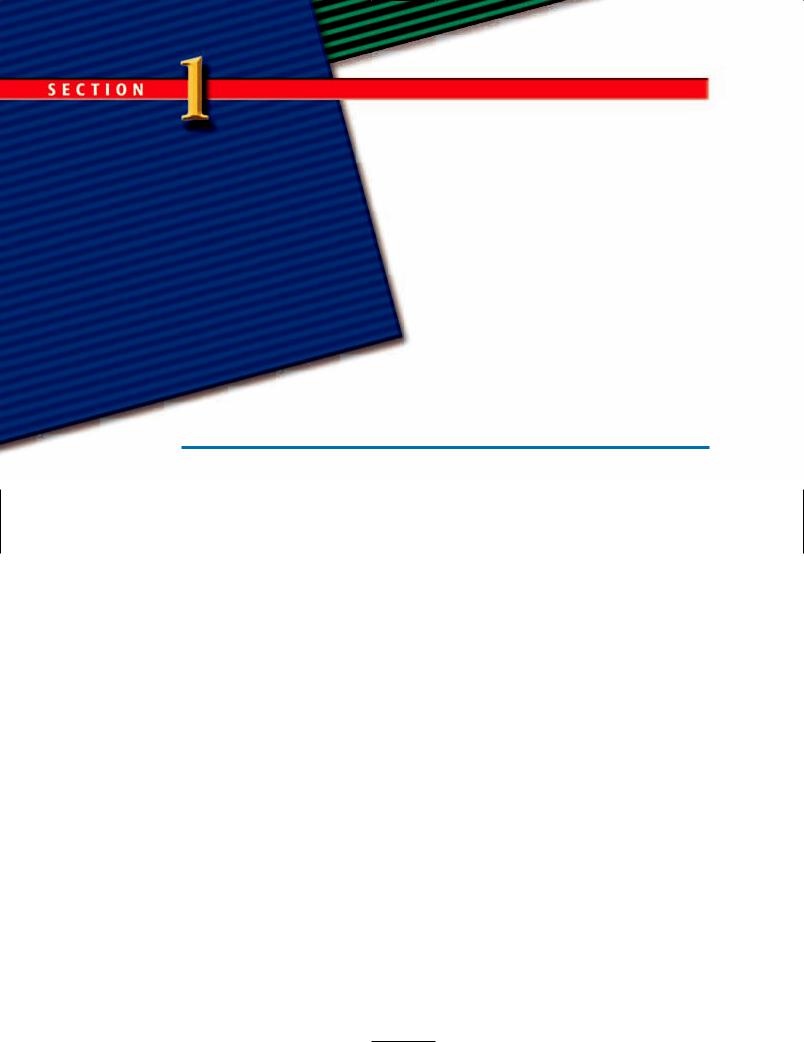
The Foundation
of Economics
Focus Questions
What is scarcity?
How is choice related to scarcity?
How is opportunity cost related to choice?
Why are rationing devices needed?
What is the purpose of a production possibilities frontier?
What activity determines the way in which rationing devices are distributed?
Key Terms
want resource scarcity
opportunity cost trade-off
production possibilities frontier rationing device
economics
want
A thing that we desire to have.
resource
Anything that is used to produce goods or services. For example, a person’s labor may be used to produce computers, TV sets, and much more, and therefore a person’s labor is a resource.
scarcity
The condition in which our wants are greater than the resources available to satisfy those wants.
Scarcity Exists
People have wants—things they desire to have. They do not want just anything, however. They want the things they think will make them happy and satisfied. Most people want cars, houses, haircuts, clothes, entertainment, better health, and countless other things. Few people are completely satisfied, even after getting their initial wants satisfied. Then they want a bigger house, a newer car, and more CDs. All the wants of all the people in the world make the list of wants unlimited.
Resources Are Needed
How do people satisfy their wants? As you probably know, in most cases you cannot get something by just wishing for it. The things we want do not simply appear on our doorsteps because we desire them. Instead, resources are needed to produce the goods and services that satisfy our wants. If you want a new desk for your room, it takes wood, tools, and labor (all of which are resources) to produce that desk. Nanette
may want a computer, but she is not going to get one by simply wishing for it. It takes many resources to produce it. (You will learn more about how economists define resources, goods, and services later in this chapter.)
Resources Are Limited
Unfortunately the world’s supply of resources is limited. So, when you want a new desk or Nanette wants a computer, you and Nanette face an ongoing problem in life that we all face, an economic problem. Our wants are unlimited, but the resources available to satisfy these wants are limited. Stated in another way, people’s wants are greater than the limited resources available to satisfy all the wants.
This condition in which our wants are greater than the resources available to satisfy them is called scarcity. Scarcity is an economic fact of life, much as the law of gravity is a fact of life. In fact, scarcity is such an important, fundamental economic concept that some economists have said that the science of economics wouldn’t exist were it not for scarcity.
6 Chapter 1 What Is Economics?

QUESTION: I know that I must deal with scarcity, but do wealthy people, people like Bill Gates, the multibillionaire, face scarcity too? Bill Gates may have unlimited wants, but doesn’t he also have unlimited resources?
ANSWER: No, both you and Bill Gates have to deal with scarcity. The fact that he can buy more “things” than you can doesn’t mean that his resources are unlimited. Keep in mind that Gates wants more than just goods, such as cars, houses, and vacations; he also wants more friendship, more time to spend with his kids, more time to do some leisurely reading. In addition, he has tried to help solve many of the world’s problems by donating millions of dollars to charities, but not even his vast fortune can provide everyone in the world with everything they want.
simply by the asking. It takes resources to bring these things about. The problem, though, is that even if we could satisfy all the wants listed here, there
would be more later. Even if we provided more health care to the poor, hired more police officers, built more schools, and cleaned up the environment, we would still discover other
things to do—always more wants and never enough resources to satisfy those unlimited wants. Therefore, we must choose how we are going to use our limited resources. We must choose which wants we will try to satisfy and which wants will be left unsatisfied.
Making Choices Means
Incurring Opportunity Costs
Every time you make a choice, such as choosing to buy a sweater instead of two
Scarcity Means Making
Choices
Wants are unlimited, and resources are limited. Therefore, scarcity exists, and people must make choices. After all, without enough resources to satisfy all our wants (yours, mine, and everybody else’s), we have to choose which wants (of the unlimited number we have) we will satisfy.
 Maria earns $1,000 a month. She wants a new outfit, 10 new books, a trip to Hawaii, a new car, and many other things. The problem is that she can’t have everything she wants, given her income. She has to choose between the new outfit or the 10 new books. She also has to choose between the trip to Hawaii and a down payment on a new car.
Maria earns $1,000 a month. She wants a new outfit, 10 new books, a trip to Hawaii, a new car, and many other things. The problem is that she can’t have everything she wants, given her income. She has to choose between the new outfit or the 10 new books. She also has to choose between the trip to Hawaii and a down payment on a new car.
Consider the choices a society makes because scarcity exists. Some groups of people want more health care for the poor, some want more police protection, some want more schools, and some a cleaner environment. As we know, wants are not satisfied
In a world of scarcity, we must make choices. Would you choose the most expensive or the least expensive shoes? How would this decision affect other decisions?
Section 1 The Foundation of Economics |
7 |

E X H I B I T 1-1 Opportunity Cost
|
What you would |
What to do |
have done |
Watch television |
Read a book |
Buy a computer |
Take a vacation |
|
in France |
Go to sleep at 9:00 p.m. |
Watch a two- |
instead of 11:00 p.m. |
hour video |
Opportunity cost
The opportunity cost of watching television is reading a book.
The opportunity cost of buying a computer is taking a vacation in France.
The opportunity cost of sleeping from 9:00
to 11:00 p.m. is watching a two-hour video.
The most valued opportunity or alternative you give up to do some- thing—the next best choice—is that something’s opportunity cost.
opportunity cost
The most highly valued opportunity or alternative forfeited when a choice is made.
trade-off
A situation in which more of one thing necessarily means less of something else.
CDs, you incur an opportunity cost. The most valued opportunity or alternative you give up (or forfeit) to do something is that something’s opportunity cost. Thus, the opportunity cost of your choosing to buy a sweater is two compact discs. (See Exhibit 1-1 for more examples.)
Economists often say that life is full of trade-offs. What do they mean by this statement? The nature of a trade-off is that you can get more of one good, but only by getting less of another good. Speaking about trade-offs is just another way of speaking about opportunity cost. In other words, saying that “life is full of trade-offs” is really no different from saying that “every time we choose one thing over another, we incur an opportunity cost.” (You will read more about trade-offs in the next section.)
QUESTION: Suppose I decide to spend $50 to buy some used car stereo speakers from a friend. If I hadn’t spent the money on the speakers, I could have purchased $50 worth of new clothes, or spent $50 on a present for my girlfriend, or given $50 to my mom’s favorite charity. Because I could have done any of these
things, aren’t all of them the opportunity cost of buying the speakers?
ANSWER: No. It is necessary to differentiate between what you could have done and what you would have done. Opportunity cost refers to what you would have done if you had not bought the speakers. It’s your next best choice, and only that choice. If you would have spent the $50 on your girlfriend’s present, then the present—and only the present— is what you actually gave up to buy the speakers. Your opportunity cost in this case can only be $50 worth of opportunity, not $100, $150, or $200 worth.
Opportunity costs affect people’s decisions every day. In fact, a change in opportunity cost can, and often does, change a person’s behavior. Suppose Sunil has a parttime job at a local grocery store. Each day he goes to work at 2 p.m. and leaves at 6 p.m. Does he incur any opportunity costs when he chooses to work each day between 2 and 6 p.m.? He certainly does; whatever he would be doing if he weren’t working is the opportunity cost of his working.
Now let’s increase the opportunity cost of Sunil’s going to work. Suppose one day Sunil is on his way to work when someone stops him and offers to pay him $300 for doing an easy task, but doing the task means that Sunil will not be able to go to work that day. What will Sunil do? Will he continue on his way to work or take the $300 and not go to work? An economist would predict that as the opportunity cost of working at his parttime job increases, compared to the benefits of working, Sunil is less likely to go to work. According to how economists think about behavior, whether it is Sunil’s or your own behavior, the higher the cost of doing something, the less likely it will be done.
 An economics professor at a California college noticed that more students are absent from class when the surf is good than when it isn’t. What might explain these absences? Well, it turned out that quite a few of the professor’s students were surfers. When the surf is not good, the
An economics professor at a California college noticed that more students are absent from class when the surf is good than when it isn’t. What might explain these absences? Well, it turned out that quite a few of the professor’s students were surfers. When the surf is not good, the
8 Chapter 1 What Is Economics?
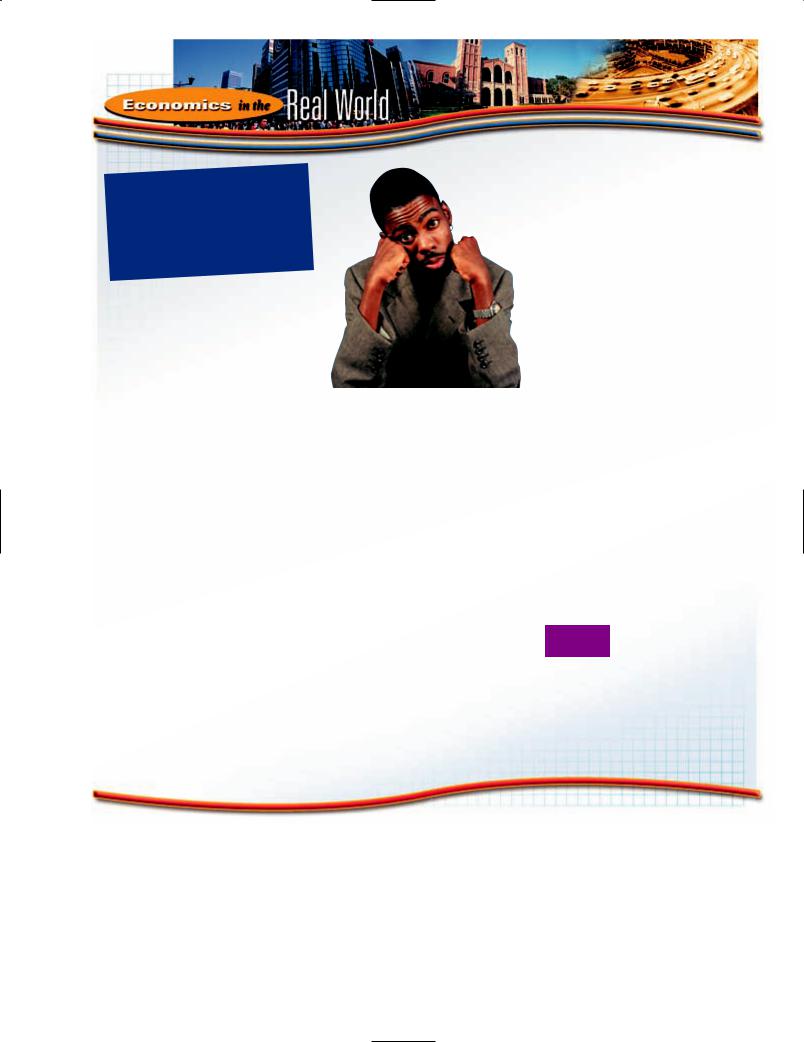
WhyDidn’t |
|
??? |
|
ChrisRockGo |
|
to |
College? |
|
|
Chris Rock was born on February 7, 1966, in
Andrews, South Carolina. Many of his early years were spent in the neighborhood of BedfordStuyvesant in Brooklyn, New York. He had two idols: one was boxer Sugar Ray Leonard and the other was comedian Eddie Murphy.
Realizing that he wasn’t much of a boxer, Chris decided to become a comedian, like Murphy.
One night, Eddie Murphy caught Chris Rock’s act at a club. He was so impressed with Rock that he cast him in his 1987 movie, Beverly Hills Cop 2. In the early 1990s, Rock became a regular on television’s Saturday Night Live. He went on to become one of America’s funniest comedians—doing movies, HBO specials, and more. Chris’s hard work and talent began paying off for him financially, with his earnings far exceeding that of the average 21-year-old.
While Chris Rock was pursuing his comedy career, many people
the same age were attending college. Why didn’t Rock go to college? He certainly could have afforded the tuition, and he would have been accepted had he applied. Could it be that the opportunity costs of attending college were just too high for Chris Rock?
“We were so poor my daddy unplugged the clocks when we went to bed.”
—Chris Rock
To understand, think what it will cost you to attend college. Let’s say that room, board, tuition, books, fees, and living expenses add up to $20,000 a year. Multiplied by 4 years that comes to $80,000. Is $80,000 really the full cost of your attending college? What would you
be doing if you didn’t go to college? Chances are that you’d be earning income working at a job. For example, perhaps you could be working at a full-time job earning $25,000 annually. Multiplied by 4 years that’s $100,000. Certainly this forfeited $100,000 is part of the cost of your attending college. Even if you earn some money working part-time while in school, you will be giving up some earnings.
How do the earnings you would give up compare to the earnings that someone like Chris Rock would have to give up? Even though the tuition, room, board, and other costs of attending college are roughly the same for everyone who attends your college, the opportunity costs will not be. Some people have higher opportunity costs of attending college than others do. Can you see how it was simply too “costly” for Chris Rock to attend college?
You may not be making hundreds of
thousands of dollars shortly after graduating from high school, but if you decide to go to college, you will have opportunity costs. What will be your opportunity costs for going to college?
opportunity cost (for the surfer students) is low and they are more likely to come to class. After all, they’re not giving up any good waves. But when the surf is good, the opportunity cost for these students is high, and they are less likely to come to class. In other words, the more the students have to
give up (in terms of good waves), the higher their opportunity cost of attending class, and the less likely they will attend class. The less students have to give up (in terms of good waves), the lower their opportunity cost of attending class, and the more likely they will attend class.
Section 1 The Foundation of Economics |
9 |
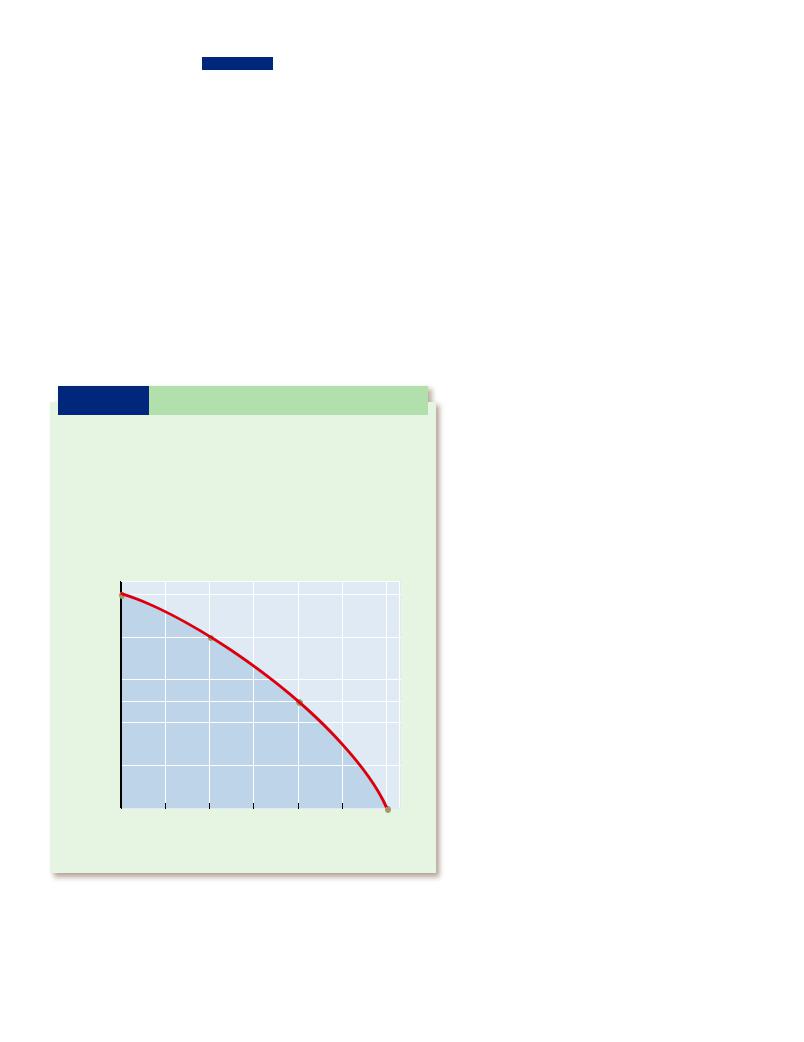
production possibilities frontier
A graphic representation of all possible combinations of two goods that an economy can produce.
High school teachers have observed that seniors, in their last semester in school, cut classes more often than any other time of the year. Does this behavior have a “surfer explanation,” which is really an opportunity cost explanation?
Yes, the opportunity cost explanation says that by the time their last semester at high school rolls around, many seniors have already been admitted to college. In their minds, missing a class here or there will not do much harm to their chances of getting into college. Let’s put it the way an economist would: the opportunity cost of going to class is less after a senior has been admitted to college than before he or she has been admitted to college; therefore, we would
E X H I B I T 1-2 Production Possibilities Frontier
|
Combination |
Snowboards |
and |
Skis |
||
|
|
|
|
|
|
|
|
|
A |
50,000 |
and |
0 |
|
|
|
B |
40,000 |
and |
20,000 |
|
|
|
C |
25,000 |
and |
40,000 |
|
|
|
D |
0 |
and |
60,000 |
|
|
|
|
|
|
|
|
|
|
|
|
(a) |
|
|
|
50 |
|
A |
|
|
|
|
|
|
|
|
|
|
year) |
40 |
|
|
B |
|
|
sands per |
|
|
|
|
||
|
|
|
|
|
||
30 |
|
|
|
|
F |
|
|
|
|
|
|||
(thou |
25 |
|
|
|
C |
|
|
|
|
|
|
||
s |
|
|
|
|
|
|
20 |
|
|
|
|
|
|
Snowboard |
|
|
|
E |
|
|
|
|
|
|
|
|
|
|
10 |
|
|
|
|
|
|
|
|
|
|
|
|
D
0 10 20 30 40 50 60
Skis (thousands per year)
(b)
The economy can produce any of the four combinations of snowboards and skis in part (a); these combinations are plotted in part (b).
expect a higher absentee rate (among seniors) when the opportunity cost of attending class is lower.
(Be aware: Some colleges will grant admission, but on the condition that a student maintain his or her GPA. In this case, then the opportunity cost of attending class is the same before and after the senior is admitted to college.)
One Diagram, Three
Economic Concepts
You have probably heard the saying, “A picture is worth a thousand words.” With that saying in mind, let’s look at a diagram that can be used to illustrate the three economic concepts we have discussed: scarcity, choice, and opportunity cost.
The diagram is called a production possibilities frontier (or PPF, for short). A production possibilities frontier shows all possible combinations of two goods that an economy can produce in a certain period of time (see Exhibit 1-2). To keep things simple, we have assumed that only two goods, snowboards and skis, can be produced in an economy. In Exhibit 1-2(a) you see the four different combinations (A–D) of these two goods that an economy can produce. For example, it can produce 50,000 snowboards and 0 sets of skis, or 40,000 snowboards and 20,000 sets of skis, and so on.
We then take each of the four combinations and plot them in Exhibit 1-2(b). If we simply connect these four points, A–D, we have a production possibilities frontier. In other words, the curve you see in Exhibit 1-2(b) is a production possibilities frontier (PPF).
Scarcity and the PPF
Now let’s think about scarcity in terms of the PPF. Scarcity, as you know, is the condition in which our wants are greater than the resources available to satisfy them. The PPF itself, the actual curve in Exhibit 1-2(b), illustrates this concept. The PPF tells us that certain things are available to us and certain things are not. We can’t have everything we
10 Chapter 1 What Is Economics?

want. Any point on the PPF itself, such as points A–D, is available to us. For example, we can have point B, which represents 40,000 snowboards and 20,000 sets of skis. We can also have the combination of goods represented by any point below the PPF, such as point E. What we can’t have—what is unavailable to us because we don’t have enough resources to produce it—is the combination of goods represented by point F, which lies beyond the PPF.
Can you see then that the PPF itself (the actual curve) illustrates scarcity by creating two regions for us? One region—consisting of points on the PPF and below it—repre- sents what is available to us. Another region (the points beyond the PPF) represents what is unavailable to us. Scarcity told us we couldn’t have everything we want, and the PPF makes this point visually clear.
Choices and the PPF
Now consider the concept of choice. We stated earlier that because of scarcity we must make choices. Looking again at Exhibit 1-2(b), we know we cannot be at points A–D at the same time. We must make a choice. Is it going to be A or B or C or D? Once we make a choice, opportunity cost “pops up.” For example, suppose we narrowed our choices down to points B and C, and in the end chose point C. What is the opportunity cost of a set of skis over this range? Well, we know that we produce 20,000 more sets of skis by choosing point C over B, but at the opportunity cost of producing 15,000 fewer snowboards. In other words, the opportunity cost of 20,000 more sets of skis is 15,000 snowboards.
A Consequence of Scarcity: The Need for a Rationing Device
Because scarcity exists, we need a rationing device, some way to decide who gets what portion of all the resources and goods available. What is the most common way in our society to determine who gets which goods, and how much each person
gets? If you guessed “money,” you were on the right track. Price (a certain number of dollars) is the most widely used rationing device in our society. If you are
willing and able to pay the price for something, it is yours. If you are either unwilling or unable to pay the price, it won’t be yours. In this way, by using
price, all products are rationed out to the people who are willing and able to pay.
If scarcity did not exist, a rationing device would not be necessary. Everyone would get everything he or she wanted.
Another Consequence of
Scarcity: Competition
Today’s world is very competitive. People compete for jobs, companies compete for profits, and students compete for grades. Economists believe that competition exists because of scarcity. If enough resources were available to satisfy all of our wants, people would not have to compete for the limited resources.
Economists also believe that competition takes the form of people trying to get more of the rationing device. If (money or dollar) price is the rationing device, people will compete to earn dollars. People compete to earn dollars every day. Say three people are up for the same promotion at their business firm. Why do they want the promotion? Certainly added prestige and responsibility may be part of the answer, but still people are more likely to seek and accept promotions that come with more money.
Suppose something other than price— muscular strength, for example—were used as the rationing device. People with more muscular strength would receive more resources and goods than people with less muscular strength. In this situation, an economist would predict that people would compete for muscular strength and would lift weights each day. The lesson is simple: whatever the rationing device, people will compete for it. See Exhibit 1-3 for a summary of the concepts described in this section.
rationing device
A means for deciding who gets what portion of the available resources and goods.
Section 1 The Foundation of Economics |
11 |
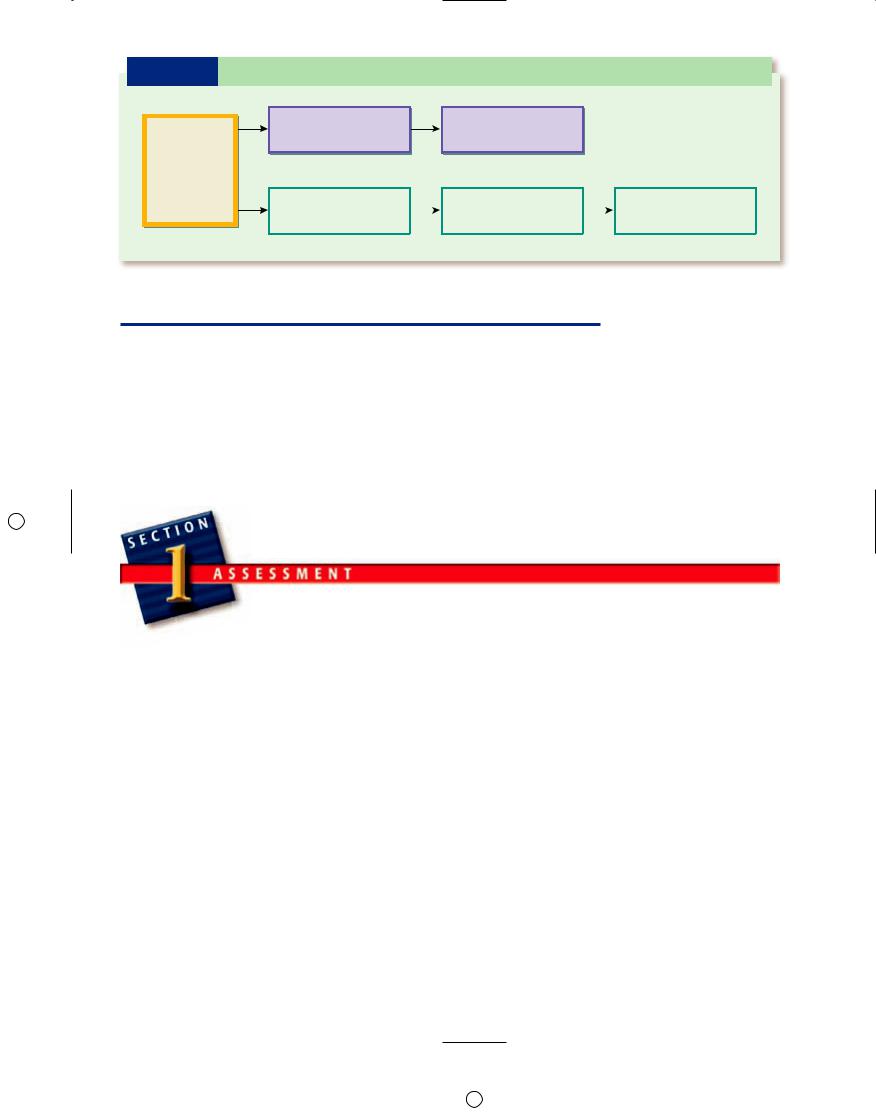
E X H I B I T 1-3 Economic Facts of Life
SCARCITY
Combination of limited resources and unlimited wants
Scarcity creates the need for |
People compete for the |
a rationing device. |
rationing device. |
|
Due to scarcity, people must |
|
|
When people make choices, |
|
|
Changes in opportunity cost |
|
make choices. |
|
|
they incur opportunity costs. |
|
|
cause changes in behavior. |
|
|
|
|
|
|
|
|
The science of economics probably would not exist were it not for scarcity—an economic fact of life.
economics
The science that studies the choices of people trying to satisfy their wants in a world of scarcity.
A Definition of Economics
In this section, you learned about three important and closely related economic concepts: scarcity, choice, and opportunity costs. You also learned something about the way economists think about the world (and you will learn more in the next section). So,
now it’s time for a formal definition of the term. Economics is the science that studies the choices people make as they try to satisfy their wants in a world of scarcity. Put another way, you could say that economics is the study of how people use their limited resources to satisfy their unlimited wants.
a.scarcity
b.opportunity cost
c.economics
d.want
e.resource
f.production possibilities frontier
g.rationing device
Reviewing Facts and
Concepts
2.Because scarcity exists, people must make choices. Explain why.
3.Give an example to illustrate how a person may incur an opportunity cost
attending high school the same for all high school students? Explain why or why not.
Critical Thinking
5.If price were not used as a rationing device, would something else have to be used? If so, what might it be? Suppose that a local movie theatre decided to use something other than price to determine who got to see the latest movies. Devise a rationing device that
Applying Economic
Concepts
6.Gallagher is planning on going to college in a few months. The tuition is $10,000 a year. Assuming that Gallagher goes to college for four years, is the opportunity cost of his attending college $40,000? Why or
why not?
7.Explain how a PPF can be used to illustrate both choice and opportunity cost.
12 Chapter 1 What Is Economics?
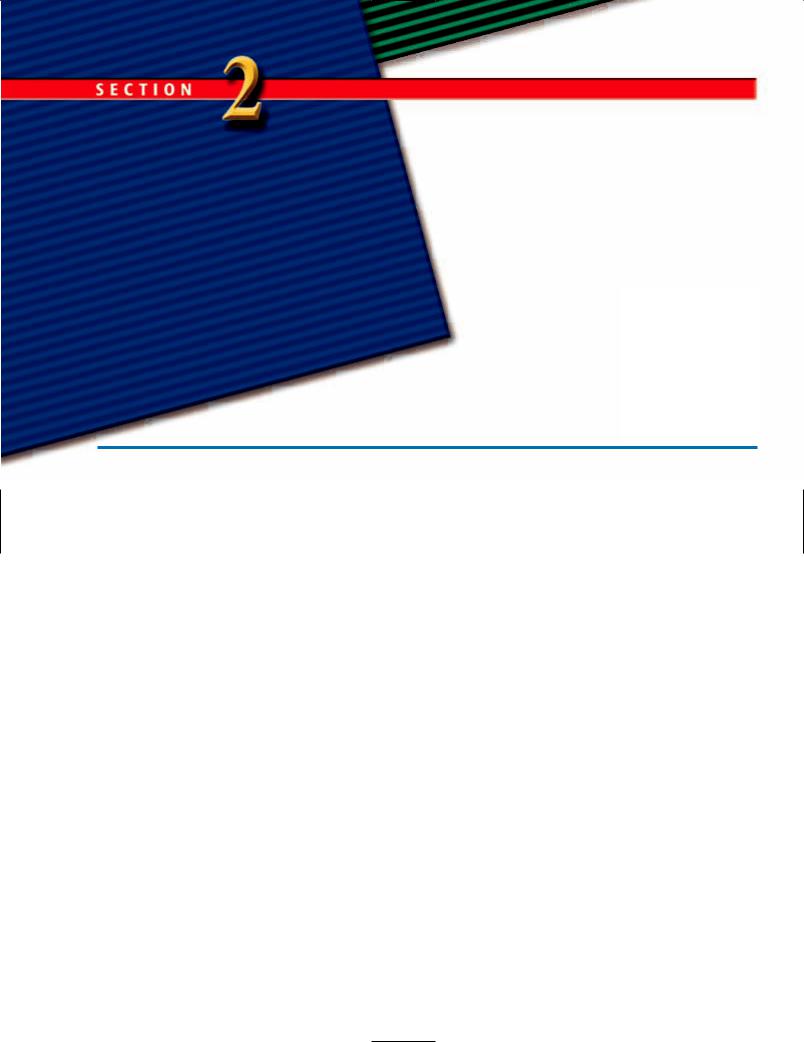
The Economic
Way of Thinking
Focus Questions
How do costs and benefits affect decisions?
What are incentives and why are they important?
What is the difference between microeconomics and macroeconomics?
Why do economists develop theories?
Key Terms
marginal incentive microeconomics macroeconomics theory
Economic Thinking
Economists have a particular way of looking at the world. Just as a pair of sunglasses can change how you view your surroundings (things look darker), so can the economic way of thinking.
When economists put on their “glasses,” they see choices and opportunity costs, as you learned in the last section. You will recall, the economist saw the surfer student being absent from class because, on the day the waves were high, the opportunity cost of attending class was higher than on other days. In other words, besides seeing a student, a surfer, the surfboard, the beach and the waves, the economist “saw” (in his mind’s eye) opportunity cost too.
One of the objectives of this book is to get you to understand and use the economist’s way of thinking. It is not the only way to look at the world. It is, however, one way of looking at the world that often does help you understand the world you live in. This new way of thinking will also, in many cases, help you get more of what you want in life.
Thinking in Terms of
Costs and Benefits
According to an economist, almost everything we do involves costs (negatives, disadvantages) and benefits (positives, advantages). There are costs and benefits to learning economics, eating a hamburger, driving a car, asking a person out on a date, sleeping an extra hour, taking a vacation, or talking on the telephone.
Making Cost-Benefit Decisions
According to the economist, a person will want to do a particular activity only if the benefits are greater than the costs. A person will buy a computer only if the benefits of buying the computer are expected to be greater than the costs of buying it. If the costs are perceived to be greater than the benefits, then the person will not purchase the computer.
Suppose a student graduates from high school and decides to go on to college. At college, she decides to major in psychology. What do we know about her choice of a
Section 2 The Economic Way of Thinking 13
